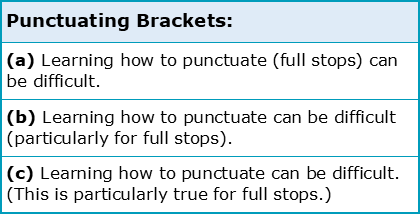Which rules of full stops are important in academia?

This is the third and final chapter about Full Stops. To complete this reader, read each chapter carefully and then unlock and complete our materials to check your understanding.
– Explore the six most important rules of full stops
– Provide examples of each rule to help guide the reader
– Discuss dialectal differences between American and British English
Chapter 3
Having already discussed the purposes and functions of full stops (otherwise known as periods), this third and final chapter on the subject next introduces and explores the six most important rules for correct and grammatical use. These rules cover topics such as how to correctly use abbreviations, brackets, citations, ellipses and quotation marks, as well as how to more generally format full stops both before and after sentences. By mastering these six rules, your writing will likely become more accurate, academic and successful.
Rule 1: Abbreviating
As was introduced in chapter 2, one useful function of the full stop is to abbreviate (shorten) a word or phrase to create an acronym, contraction or initialism. However, whether or not full stops should be included at the end of an abbreviation or between each letter of that abbreviation can be a confusing aspect of punctuation for some students. With this in mind, it’s important to note that some of this confusion may simply be due to differences between how American and British people use this punctuation mark:

Looking at this table, we can see that for titles and honorifics such as ‘Mr’ and ‘Mrs’, the general rule here is that Americans end these abbreviations with a full stop while British speakers do not. The only instance in which British people would be correct in finishing similar abbreviations with a full stop is when the abbreviated honorific doesn’t contain its initial and final letters – such as the ‘p’ and ‘r’ in ‘professor’, which when abbreviated becomes ‘prof.’
This is not the only inconsistency when adding full stops to abbreviations, however. You may have also noticed that both ‘USA’ and ‘U.S.A’ are acceptable, although the former is undoubtedly much more common – particularly in British English. In truth, most abbreviations are never written with full stops in either dialect, while some abbreviations such as ‘pop.’ (for ‘population’) may be electively written with a full stop so that the word is not confused with another abbreviation, such as the ‘pop’ in ‘pop music’. Whichever dialect you do decide to follow, the most important aspect here is that you remain consistent within your own work. The following British rules and tendencies may help you to remain consistent:
- Do not punctuate abbreviations with capital letters, such as BBC
- Do punctuate abbreviations with lower-case letters, such as e.g. or etc.
- Do not use full stops with contractions in which the first and last letter of the contraction are the same, such as Dr (doctor) or St (street)
- Do use full stops with abbreviations in which the first and last letter of the abbreviation are not the same, such as ‘Prof.’ (professor) or ‘Co.’ (company)
- If a sentence ends in an abbreviation that takes a full stop, do not include an additional full stop to the end of that sentence
Rule 2: Bracketing
Brackets, otherwise known as parentheses, can be used to provide an aside thought within a sentence or piece of writing. There are two rules to follow here when using such brackets grammatically, and these are:
- If a part of a sentence is enclosed in brackets, place the full stop outside of the brackets and at the end of the complete sentence. (a/b)
- If a complete sentence is enclosed in brackets, place the full stop within those brackets only. (c)

Rule 3: Citing
Very important when referencing is knowing how to cite correctly, and full stops play an important role here too. Of course, the referencing style you’re using (whether Harvard or Chicago style, for example) will affect the rules of how to correctly punctuate citations, but the general advice is (a) when a citation is placed at the end of a sentence, the full stop must be placed outside of (and after) that citation, and (b) when using endnotes and footnotes, the full stop should be placed before the in-text numeral:

Rule 4: Formatting
One clear rule when formatting full stops is that there should be no space given between the final word of a sentence and its full stop. However, how much space a writer should then provide between that full stop and the first word of the next sentence is somewhat open to debate. There are three methods that may be applied in such situations:
(1) use a single space after the full stop (this is called French spacing)
(2) use a double space (known as English spacing)
(3) use one widened space (or em space).
While some traditionalists argue that the English double space is recommended, seeing as almost all books, magazines, websites and other publications use the single French space between the full stop and the beginning of the next sentence, we recommend that you also do the same and stay consistent.
Rule 5: Omitting
Sometimes, three full stops in a row (…) may be used by a writer to indicate that words have been deleted from a sentence or quotation. This is called ellipsis. While some grammarians may argue differently, the most commonly applied rule is that ellipses should not be used in conjunction with full stops. As can be seen in the following examples, these three dots may be used to end or begin a sentence:

Rule 6: Quoting
Finally, it’s also important to pay careful attention to how you use full stops when correctly punctuating quotations within your writing. Much like for abbreviations, there is some variation here between British and American English, and so a good writer should decide which dialect they’re going to follow and remain consistent.
As can be seen in the following examples, the full stop (or period) is always placed within the quotation marks if that quotation comes at the end of a sentence in American English – even if it doesn’t seem sensible to do so. In British English, however, the full stop should only be placed within the quotation marks if the original quotation also had a full stop in exactly the same place – as in Quotation B below:


Congratulations on completing this short reader about full stops in the English language. Have you considered now testing your knowledge of this topic by unlocking and downloading our related materials, or reading about another sentence-punctuation topic?
Downloadables
Collect Academic Marks
-
100 Marks for joining
-
25 Marks for daily e-learning
-
100-200 for feedback/testimonials
-
100-500 for referring your colleages/friends